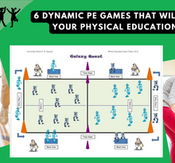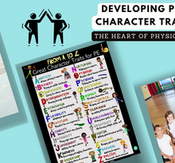Exploring Non Locomotor Movements: A Comprehensive Guide to Non Locomotor Skills
Movement is an important part of human life. We move to get from one place to another, to interact with our environment, and to express ourselves. In physical education, we often focus on locomotor movement – the types of movement that involve traveling from one place to another. However, there is a lot of value in incorporating non-locomotor movement into our classes as well. Non-locomotor movements are those that do not involve traveling from one place to another.

In this blog post article, I will define non-locomotor movement and examine SHAPE America's non-locomotor Grade Level Outcomes for elementary-aged students. I will also discuss the benefits of using non-locomotor movement in physical education classes and highlight the top 10 movements for incorporating them into your lesson plans.
Definition
Non-Locomotor movement can be defined as movements that occur in the body parts or using the whole body but do not cause the body to travel to another space. In other words, it means "Moving without Moving"!!
SHAPE America's Grade Level Outcomes for
Non-Locomotor Movement (Elementary)
SHAPE America highlights several non-locomotor movement Grade Level Outcomes for elementary-aged students that include:
Kindergarten
Forms wide, narrow, curled, and twisted body shapes. (S1.E7.Kb)
Rolls sideways in a narrow body shape. (S1.E9.K)
Contrasts the actions of curling and stretching. (S1.E10.K)
1st Grade
Maintains stillness on different bases of support with different body shapes. (S1.E7.1)
Transfers weight from one body part to another in self-space in dance and gymnastics environments. (S1.E8.1)
Rolls with either a narrow or curled body shape. (S1.E9.1)
Demonstrates twisting, curling, bending, and stretching actions. (S1.E10.1)

2nd Grade
Balances on different bases of support, combining levels and shapes. (S1.E7.2a)
Balances in an inverted position with stillness and a supportive base. (S1.E7.2b)
Transfers weight from feet to different body parts/bases of support for balance and/or travel. (S1.E8.2)
Differentiates among twisting, curling, bending, and stretching actions. (S1.E10.2)
Combines balances and transfers into a 3-part sequence (i.e. dance, gymnastics). (S1.E11.2)
3rd Grade
Balances on different bases of support, demonstrating muscle tension and extensions of free body parts. (S1.E7.3)
Transfers weight from feet to hands for momentary weight support. (S1.E8.3)
Moves into and out of gymnastics balances with curling, twisting, and stretching actions. (S1.E10.3)
Combines locomotor skills and movement concepts (levels, shapes, extensions, pathways, force, time, flow) to create and perform a dance. (S1.E11.3)
Combines balance and weight transfer with movement concepts to create and perform a dance. (S1.E12.3)

4th Grade
Balances on different bases of support on apparatus, demonstrating levels and shapes. (S1.E7.4)
Transfers weight from feet to hands varying speeds and using large extensions (e.g., mule kick, handstand, cartwheel). (S1.E8.4)
Moves into and out of balances on apparatus with curling, twisting, and stretching actions. (S1.E10.4)
Combines locomotor and movement concepts (levels, shapes, extensions, pathways, force, time, flow) to create and perform a dance with a partner. (S1.E11.4)
Combines traveling with balance and weight transfers to create a gymnastics sequence with and without equipment/ apparatus. (S1.E12.4)
5th Grade
Combines balance and transferring weight in a gymnastics sequence or dance with a partner. (S1.E7.5),
Transfers weight in gymnastics and dance environments. (S1.E8.5)
Performs curling, twisting, and stretching actions with correct application in dance, gymnastics, and small-sided practice tasks/games environments. (S1.E10.5)
Combines actions, balances and weight transfers to create a gymnastics sequence with a partner on equipment/apparatus. (S1.E12.5)
Combines actions, balances and weight transfers to create a gymnastics sequence with a partner on equipment/apparatus. (S1.E12.5)

Benefits of non-locomotor movement in PE
There are many benefits to incorporating non-locomotor movement into physical education. One benefit is that it helps students develop body awareness and control. Non-locomotor movements require students to use different parts of their bodies and to be aware of how their bodies are moving through space. This also helps them improve their focus and concentration. When students are focused on the movement they are doing, they are less likely to be distracted by other things going on around them.
Another benefit of non-locomotor movement is that it can help improve students' balance and coordination. Balance and coordination are important skills for students to have to participate in physical activity safely and effectively. Non-locomotor movements can help students develop these skills by challenging them to maintain their balance while moving their bodies in different ways.
Finally, non-locomotor movement can help students develop strength and flexibility. Many non-locomotor movements require students to use their muscles in new ways, which can help them build strength. And, because many non-locomotor movements involve stretching or reaching, they can also help students increase their flexibility.
Now that we have looked at the benefits of this non-locomotor movement, let's explore some of the individual movements that constitute it.
Top 10 Non-Locomotor Movements
Balance: An even distribution of weight enabling you to remain upright and steady (ex. gymnastics, golf)
Bend: To move from a straight position into a curved position at a joint (ex. dance, cheerleading)
Curl: To form your body into a curved shape (ex. fitness, rowing)
Pull: executing force to cause objects/people to move toward one's body (ex. tug-o-war, pull-ups)
Push: Applying force against an object or person to move it away from one's body or to move one's body away from the object or person (ex. fitness, shotput)
Stretch: Causing a specific muscle to become longer than its normal resting length (ex. Yoga, bowling)
Sway: Shifting weight from one side to the other side in a smooth fashion (ex. twirling a hoop, dancing)
Swing: Moving a body part side to side or forward and back like a pendulum (ex. aerobics, cross-fit)
Turn: Rotating the body along the long axis (ex. ballet, gymnastics)
Twist: The rotation of a body part around its axis (ex. tumbling, dance)
Many of the movement skills listed above are utilized in a variety of physical education activities, games, and sports. They are often combined with other fundamental body movements such as locomotor movement and manipulative skills. Defining the terms, along with demonstrating and practicing the skills will allow our students to learn the different movement concepts and help them acquire the skills necessary for increasing their overall physical literacy.
Incorporating into a class
There are a variety of ways that you can incorporate non-locomotor movement into your physical education classes. One way is to use it as a warm-up activity. Non-locomotor movements can help students loosen up their muscles and prepare their bodies for the activities to come. You can also use non-locomotor movements to teach specific skills or concepts. For example, if you are teaching students to swing a bat from a tee, they can first perform the motion without the bat, using only their body. Additionally, non-locomotor movements can be used as a cool-down activity. This can help students wind down after strenuous activity and prepare their bodies for rest.
In Summary
So, as you can see, there are many benefits to incorporating non-locomotor movement into physical education. Non-locomotor movements can help students develop body awareness and control, balance and coordination, and strength and flexibility. All of these are important skills for students to have to participate in physical activity safely and effectively.
So next time you're planning a physical education lesson, consider incorporating some non-locomotor movements into the lesson to give your students a chance to develop these important movement skills.
Do you have any tips for incorporating non-locomotor movement into physical education classes? Let me know in the comments below!
Need resources?
Do you need a practical way to display non-locomotor movements like the ones listed above? If you do, Cap'n Pete's Power PE has you covered!

Fill out the form below to download a FREE non-locomotor movement visual that you can use with your students. The PE Poster: Non-Locomotor Movement (in 5 color schemes) serves as a practical instructional graphic for teachers to use to share 10 different non-locomotor movements that are typically performed in a physical education class. You can place it inside your gym or learning area for your students to see and for you to reference while you teach your daily physical education lessons.
If you're searching for a way to spice up your PE learning area, Cap'n Pete's Fitness and Movement Sign Bundle- Top 10 Movement Visuals is the perfect supplement. The fitness and movement sign bundle (top 10 movements) is an 8-set collection of large print, easy to read visual sign packages that include: 1. Balance Skills, 2. Cardiovascular Endurance, 3. Flexibility, 4. Locomotor Movement, 5. Manipulative Skills, 6. Muscular Endurance, 7. Muscular Strength and Power, and 8. Non-Locomotor Movement.
You can download them from either of the following platforms: Cap'n Pete's Power PE Website or Teachers Pay Teachers- Cap'n Pete's TPT Store























